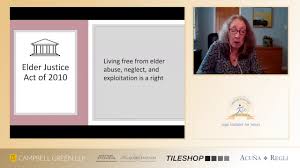As part of the Patient Protection and Affordable Care Act, Congress established the Elder Justice Act (EJA) 2010 in response to growing concerns about elder abuse.
President Obama signed this into law on March 23, 2010.
According to the US Department of Justice, elder abuse is a significant and frequently unreported issue.
Statistics are difficult to evaluate accurately as only one of every 23 incidents is reported to the proper agencies.
Note that everyone above the age of 60 is an “Older American”. Family members, caregivers, or nursing home employees may commit physical, sexual, or emotional abuse or fraud against elderly people
Interestingly, the elder justice act 2010 has much to offer older people. As you read through this article, you’ll find more.
What is the Elder Justice Act 2010?
The Elder Justice Act passed in 2010, is the first comprehensive federal legislation to combat older individuals’ abuse, neglect, and exploitation.
The bill allowed several programs and efforts to better coordinate federal responses to elder abuse, promote elder justice research and innovation, assist adult protective services networks, and provide greater protections for residents of long-term care facilities.
The Elder Justice Act 2010 established the Elder Justice Coordinating Committee. This is to also coordinate efforts against elder abuse, neglect, and exploitation across the federal government.
Purposes of the Elder Justice Act (EJA), 2010
Note, the Elder Justice Act 2010 is the first comprehensive national law to address elder abuse, and it applies to seniors 60 years of age or older.
Coordination of federal and state agency responses to elder abuse is one of its goals. It supports initiatives aimed at early abuse detection and prevention.
The Elder Justice Act works to advance elder justice, which it describes as initiatives to “prevent, detect, treat, intervene in, and prosecute elder abuse, neglect, and exploitation [and] protect elders with diminished capacity while maximizing their autonomy.”
Legal and Social Provisions of the Elder Justice Act, 2010
As previously stated, the EJA established agencies to combat and coordinate responses to elder abuse.
It also tightened reporting standards like:
- forming the Elder Justice Coordinating Council.
- Creating the Elder Abuse, Neglect, and Exploitation Advisory Board (“The Advisory Board”),
- Supporting Forensic Centers for Elder Abuse, Neglect, and Exploitation
- Requiring quick reporting of crimes in long-term care institutions
- Penalties for any retaliation against persons who report infractions
- directing a study on the establishment of a national nurse aide register that will include criminal background checks
The Council and Advisory Board
Again, the Council, established by the Elder Justice Act, 2010 coordinates the efforts of federal, state, local, and private agencies to combat elder abuse. Congress is also obligated to receive the Council’s findings and recommendations.
It issued its initial recommendations in May 2014. Note that the Advisory Board was formed to assist the Council in establishing plans and recommendations to address elder abuse.
Furthermore, The Advisory Board comprises 27 people nominated by the Secretary who are specialists in elder abuse, neglect, and exploitation.
Forensic Centers for Elder Abuse
The Elder Justice Act of 2010 allowed grants to establish up to ten forensic facilities. These institutes honed their skills in detecting elder abuse and assisting victims.
In particular, the forensic centers:
- Create criteria for determining when elder abuse has happened and whether it constitutes a crime.
- Learn about victim support and case evaluation, tracking, and review.
- Finally, provide statistics to the Secretary of Health and Human Services (DHHS) and the United States Attorney General.
Penalties and Reporting Requirements for the Elder Justice Act, 2010
Before the passage of the Elder Justice Act, there were specific procedures for reporting occurrences of elder abuse.
The Elder Justice Act expanded similar restrictions to long-term care facilities that received at least $10,000 in federal subsidies in 2010.
The Elder Justice Act requires facility owners, operators, employees, managers, agents, or contractors (covered personnel) to report any reasonable suspicion of a crime against a resident or anybody receiving care from the institution.
What Exactly Is a “Long-Term Care Facility” According to the Elder Justice Act, 2010?
The Act covers any “long-term care facility” that received at least $10,000 in government money the previous year. According to the Act, a facility is a residential care provider coordinating or offering direct long-term care.
“Long-term care” is defined by the Act as “supportive” and “health services.”
According to the Act, some examples of long-term care facilities are:
- Healthcare facilities
- Facilities for skilled nursing
- Anxious hospices
- Facilities for intermediate mental health care.
According to the Department of Health and Human Services (“HHS”), the Act does not apply to assisted living facilities.
Additionally, it does not apply to short-term care, including hospice, physical rehabilitation facilities, or hospitals for brief hospital stays.
What Constitutes “Covered Individuals?”
A long-term care facility subject to the Act must annually advise its “covered individuals” of its reporting requirements.
These persons are required to report any “reasonable suspicion” of a crime against an elderly resident.
These reporting requirements are forwarded to the relevant HHS state survey agency and at least one local law enforcement agency.
In other words, practically everybody who works at a long-term care facility that received $10,000 or more in federal funds during the previous calendar year is eligible.
These institutions must inform their employees and contractors of their responsibility to report any “reasonable suspicion.”
Note that the following persons or organizations may be held accountable if a crime is committed against an elderly citizen and it is not reported:
- The HHS state survey agency that is appropriate
- A unified local police force
What Does “Reasonable Suspicion” of a Crime Mean?
The usual legal term of “reasonable suspicion,” even though the Act doesn’t define it, offers insight. The relevant local subdivision’s law specifies each offense. This refers to the local and state criminal legislation where the long-term care provider is situated.
For instance, if a worker at a nursing home governed by the Act in California has an elderly patient, the worker has a good reason to think that this resident is the victim of state or municipal law violations.
That employee must disclose abuse as soon as possible.
Reporting Requirements
Let’s assume that a covered person has a solid suspicion that a crime was committed. An elderly individual suffered significant physical harm as a result of the incident.
The person has 24 hours to report the suspicion if it is based on circumstances that did not result in serious physical harm.
For instance, if a nurse notices significant bruising on an older person early in the day, after some consideration, the nurse concludes that a crime was the cause of the bruises.
In this case, the nurse had to report the bruising two hours after noticing it.
On the other hand, the nurse has 24 hours from the time they suspect financial exploitation or theft to report it if they think a coworker is taking money from an old resident.
Penalties for Breaking the Elder Justice Act
Individual fines and penalties against care institutions are provided for in the Act. A covered individual can violate the Act by failing to disclose a reasonable suspicion of a crime committed against an elderly resident within the timeframe specified. The maximum civil penalty is $200,000 per offense.
The maximum civil penalty is $300,000 if failing to notify the suspect intensifies the harm to the senior resident or another person.
A facility that retaliates against a covered individual who reports their suspicions of a crime faces a $200,000 civil penalty.
They might also lose access to government subsidies. Retaliation usually involves dismissing, demoting, or harassing the person who reported the abuse.
Obtaining Legal Counsel for Elder Justice Act Violations
Healthcare professionals and establishments that care for older people must understand the Elder Justice Act reporting obligations.
In principle, any senior care home employee with reasonable suspicion of a crime being committed against a resident must report it.
The institution may not retaliate against this employee.
Employee failure to report and retribution by the facility against a reporting employee may result in civil penalties.
Summary:
In response to growing concerns about elder abuse, the Patient Protection and Affordable Care Act included the Elder Justice Act (EJA), 2010.
It is the first comprehensive federal legislation to combat elder abuse, neglect, and exploitation.
In other words, It allows for better coordination of federal responses to elder abuse, promotes elder justice research and innovation, assists adult protective services networks, and provides greater protections for long-term care facility residents.
In summary, the Act promotes elder justice initiatives, defined as efforts to “prevent, detect, treat, intervene in, and prosecute elder abuse, neglect, and exploitation [and] protect elders with diminished capacity while maximizing their autonomy.”
Related articles:
Is California a No-Fault State?



